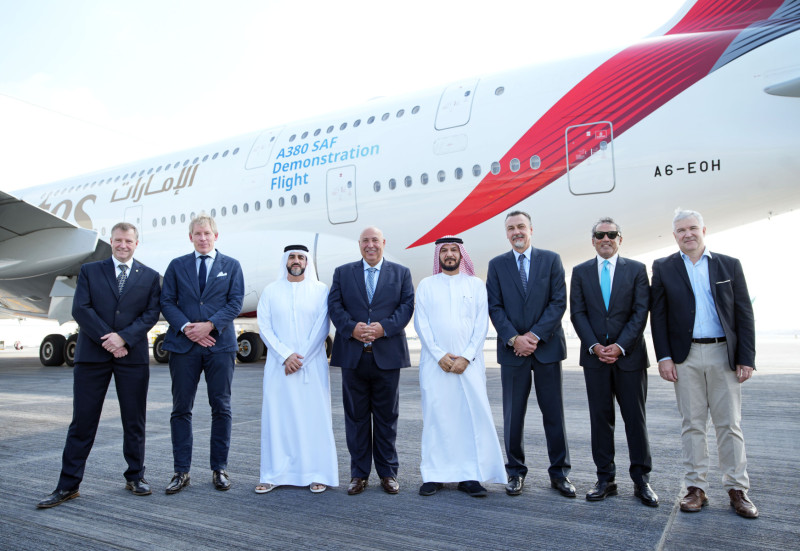Emirates has operated the ‘first-ever 100% SAF flight’ with an Airbus A380 with SAF in one of its four engines for the 37-minute flight
Emirates, the Dubai International Airport-based airline, operated a flight with an Airbus A380 fueled with 100% Sustainable Aviation Fuel (SAF). According to the carrier, it was the first to do so, partnering with Airbus, Engine Alliance, Pratt & Whitney, ENOC, Neste, and Virent to achieve the feat. One out of the four engines was powered by 100% SAF.
- Emirates operated the first-ever flight with an Airbus A380 completely fueled by Sustainable Aviation Fuel (SAF).
- SAF reduces carbon emissions by up to 85%, making it a more sustainable alternative to traditional jet fuel, and this flight paves the way for future adoption of 100% SAF flying.
- Emirates has been working with various partners to test and analyze the use of SAF, and it has also started operating commercial flights using SAF, provided by Shell Aviation and Neste.
In a press statement Emirates said: “Today’s flight, proudly commanded by Captain Khalid Binsultan and Captain Philippe Lombet, took off from Dubai International Airport (DXB) with one of four engines powered on 100% SAF, helping demonstrate its potential as a drop-in replacement that matches jet fuel’s technical and chemical requirements, while being a more sustainable alternative. SAF can reduce carbon emissions by up to 85%* over the fuel’s life cycle when compared to conventional jet fuel.
“Demonstration flights like the one conducted today pave the way for future standardisation, qualification and adoption for 100% SAF flying, as governments adopt broader strategies to support the production and scale up of SAF. The A380 demonstration flight underlines the performance and compatibility of SAF, making it a safe and reliable fuel source, and contributes to the growing body of research carried out by the industry to evaluate the beneficial effects of 100% SAF on aircraft performance. SAF is currently capped at a 50% blend limit in engines for commercial flights.”
The Emirates A380 demonstration flight comes as the aviation industry, international organisations, regulatory bodies and high-level officials driving policy-related decisions converge in Dubai for the Third International Civil Aviation Organization (ICAO) Conference on Aviation and Alternative Fuels (CAAF/3). Dedicated collaborators from Airbus, Engine Alliance, Pratt & Whitney, Neste, Virent and ENOC have been working on the testing, technical assessments and data analysis for today’s flight.
The 100% drop-in SAF used on today’s flight includes renewable aromatics and closely mimics the characteristics of conventional jet fuel. This is the first time that drop-in SAF has been used on an A380 aircraft, with the expectation of full compatibility across the aircraft’s existing systems. The flight carried four tonnes of SAF, comprised of HEFA-SPK provided by Neste (hydro processed esters and fatty acids synthetic paraffinic kerosene) and HDO-SAK from Virent(hydro deoxygenated synthetic aromatic kerosene). ENOC helped to secure the neat SAF comprised of HEFA-SPK, and blended it with Sustainable Aviation Kerosene (SAK) at its facility in Dubai International Airport ahead of the demonstration, and also carried out into-plane services.
The 100% SAF was used in one Engine Alliance GP7200 engine, while conventional jet fuel was used in the other three engines. The PW980 auxiliary power unit (APU) from Pratt & Whitney Canada also ran on 100% SAF.
According to Emirates, the flight with 100% SAF proved alternative fuels’ potential “as a drop-in replacement that matches jet fuel’s technical and chemical requirements, while being a more sustainable alternative.” The carrier also added that SAF reduces carbon emissions by up to 85%, with the reductions calculated using established lifecycle assessment (LCA) methodologies, such as the International Civil Aviation Organization’s (ICAO) Carbon Offsetting and Reduction Scheme for International Aviation (CORSIA).
Flightradar24 data showed that A6-EOH departed and arrived at DXB after spending 37 minutes in the air. Before it departed on the demonstration flight, the aircraft sat in Dubai for six days after it had arrived from Munich Airport on November 16. Emirates pointed out that Airbus, Engine Alliance, a joint venture between Pratt & Whitney and GE Aerospace, Pratt & Whitney, Neste, Virent, and ENOC “have been working on the testing, technical assessments and data analysis for today’s flight.”
Adel Al Redha, the Chief Operating Officer at Emirates, said: “Emirates is the first passenger airline in the world to operate an A380 with 100% drop-in SAF powering one of four Engine Alliance GP7200 engines. This is another proud moment for Emirates and our partners, as we put words into action with the research into and the trialling of higher concentrations of SAF to eventually lead to industry adoption of 100% SAF flying.
“This marks another significant step in validating the use of SAF in one of the engines of the A380, a wide-body aircraft with four engines. The growing global demand for lower-emission jet fuel alternatives is there, and the work of producers and suppliers to commercialise SAF and make it available will be critical in the coming years to help Emirates and the wider industry advance our path to lower carbon emissions.”





